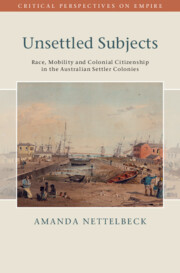Refine search
Actions for selected content:
408 results
15 - Material Culture
- from Part IV - Living with Saints
-
-
- Book:
- The Cambridge Companion to Counter-Reformation Sanctity
- Published online:
- 12 December 2025
- Print publication:
- 08 January 2026, pp 303-327
-
- Chapter
- Export citation
1 - The Limit of Afro-Mexico
- from Part I - Freedom and Colonial Legacies
-
-
- Book:
- Afro-Mexican Lives in the Long Nineteenth Century
- Published online:
- 20 November 2025
- Print publication:
- 04 December 2025, pp 35-62
-
- Chapter
- Export citation
4 - The Ostheer: Leadership, Command, Motivation, and Experience
- from Part II - Opposing Forces
-
-
- Book:
- The Cambridge Companion to the Nazi-Soviet War
- Published online:
- 13 November 2025
- Print publication:
- 20 November 2025, pp 67-89
-
- Chapter
- Export citation
Introduction
-
- Book:
- Unsettled Subjects
- Published online:
- 13 November 2025
- Print publication:
- 20 November 2025, pp 1-14
-
- Chapter
- Export citation
Chapter 14 - Aesthetics of Immobility and the Digital in Afropolitan Literatures
- from Part III - Contemporary Reconfigurations or Shifting Globalities and Positionalities
-
-
- Book:
- African Literature in Transition
- Published online:
- 07 November 2025
- Print publication:
- 20 November 2025, pp 253-269
-
- Chapter
- Export citation

Unsettled Subjects
- Race, Mobility and Colonial Citizenship in the Australian Settler Colonies
-
- Published online:
- 13 November 2025
- Print publication:
- 20 November 2025
11 - Mobility and Authority
-
- Book:
- Politics as Exchange
- Published online:
- 23 October 2025
- Print publication:
- 06 November 2025, pp 182-206
-
- Chapter
- Export citation
Introduction
-
-
- Book:
- African Literature in Transition
- Published online:
- 23 October 2025
- Print publication:
- 06 November 2025, pp 1-12
-
- Chapter
-
- You have access
- HTML
- Export citation
3 - Work and Merit in a New Republic
-
- Book:
- Self-Made
- Published online:
- 30 October 2025
- Print publication:
- 30 October 2025, pp 57-80
-
- Chapter
- Export citation
1 - A New World of Ambition and Judgment
-
- Book:
- Self-Made
- Published online:
- 30 October 2025
- Print publication:
- 30 October 2025, pp 10-33
-
- Chapter
- Export citation
9 - Being a Public Woman: Streets, Cars, Crimes, and the Shifting Calculus of Moral Accountability
-
- Book:
- Tied Up in Tehran
- Published online:
- 28 September 2025
- Print publication:
- 16 October 2025, pp 228-256
-
- Chapter
- Export citation
Prologue
-
- Book:
- The Archaeology of Pastoralism, Mobility, and Society
- Published online:
- 04 September 2025
- Print publication:
- 18 September 2025, pp 1-19
-
- Chapter
- Export citation
Chapter Six - Multidisciplinary Means of Addressing Pastoral Ecologies and Economies in the Past
-
- Book:
- The Archaeology of Pastoralism, Mobility, and Society
- Published online:
- 04 September 2025
- Print publication:
- 18 September 2025, pp 258-272
-
- Chapter
- Export citation
Chapter Five - Biomolecular Approaches to Pastoralism, Diet, and Mobility in the Past
-
- Book:
- The Archaeology of Pastoralism, Mobility, and Society
- Published online:
- 04 September 2025
- Print publication:
- 18 September 2025, pp 216-257
-
- Chapter
- Export citation
Chapter Two - Resolving Conceptual Conflation
-
- Book:
- The Archaeology of Pastoralism, Mobility, and Society
- Published online:
- 04 September 2025
- Print publication:
- 18 September 2025, pp 56-104
-
- Chapter
- Export citation
A Genre in Flux: Grand opéra Through the Lens of French Touring Companies, 1830–1860
-
- Journal:
- Cambridge Opera Journal , First View
- Published online by Cambridge University Press:
- 01 September 2025, pp. 1-24
-
- Article
-
- You have access
- Open access
- HTML
- Export citation
Chapter 2 - Writing between the Lines
-
- Book:
- Railway Infrastructure and the Victorian Novel
- Published online:
- 12 August 2025
- Print publication:
- 28 August 2025, pp 45-69
-
- Chapter
- Export citation
10 - Mobility, Livability, and Sustainability
- from Part II - Application Case Chapters
-
- Book:
- Cities and Environmental Change
- Published online:
- 15 August 2025
- Print publication:
- 28 August 2025, pp 215-242
-
- Chapter
- Export citation
Nuevos aportes desde el análisis de δ18O y δ13C a la movilidad de los camélidos en el Valle de Ambato, Catamarca, Argentina
-
- Journal:
- Latin American Antiquity , First View
- Published online by Cambridge University Press:
- 27 August 2025, pp. 1-19
-
- Article
- Export citation
4 - Knowledge Transfers
-
- Book:
- The Colonial Way of War
- Published online:
- 04 September 2025
- Print publication:
- 21 August 2025, pp 188-238
-
- Chapter
- Export citation
